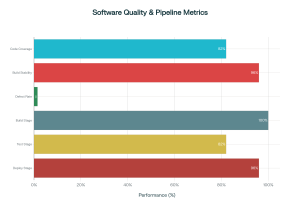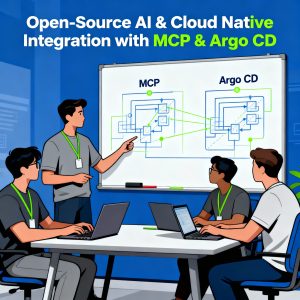As artificial intelligence continues to evolve, one of the most transformative concepts emerging is that of AI agents. Unlike traditional AI models or bots that respond to user inputs, AI agents are goal-driven, autonomous systems capable of perceiving their environment, making decisions, and taking actions to achieve specific objectives.
AI agents are increasingly used across industries to automate complex workflows, make intelligent decisions, and adapt to changing environments without constant human intervention.
This blog explores:
- What AI agents are and how they work
- The key benefits and architecture of AI agents
- The difference between AI agents, bots, and assistants
- Use cases, types, and limitations
- Real-world examples and the future of AI agent adoption
How AI Agents Work?
At their core, AI agents operate on a continuous perception-action loop. They interact with the world or environment in a cyclical manner:
- Perceive – Sense data or inputs from the environment (e.g., APIs, files, sensors, user input).
- Decide – Evaluate the input using rules, logic, or AI models to determine the best course of action.
- Act – Perform actions such as making API calls, altering a system state, or delivering outputs.
This loop allows AI agents to adapt to new data and contexts while progressing toward their goals.
Basic Agent Pseudocode:
python
class SimpleAIAgent:
def __init__(self, goal):
self.goal = goal
def perceive(self, environment):
return environment.get_current_state()
def decide(self, state):
if state == 'obstacle':
return 'turn'
return 'move_forward'
def act(self, action):
print(f"Executing action: {action}")
def run(self, environment):
while not environment.goal_achieved():
state = self.perceive(environment)
action = self.decide(state)
self.act(action)What Are the Benefits of Using AI Agents?
AI agents offer distinct advantages for both developers and enterprises:
- Autonomy: They can operate without human oversight, pursuing goals independently.
- Productivity: They free up human effort by handling repetitive or complex workflows.
- Scalability: A single AI agent can be replicated or scaled across thousands of tasks.
- Contextual Decision-Making: Unlike static bots, agents make decisions based on context and history.
- Improved CX: In customer-facing roles, agents deliver faster, smarter responses.
For example, a financial AI agent might analyze your expenses, suggest savings plans, and automatically allocate funds—without needing daily prompts.
What Are the Key Components of AI Agent Architecture?
Though implementations vary, most AI agents share a common structure:
- Perception Module – Captures real-time data through APIs, sensors, or inputs.
- Memory – Stores context, environment history, and learned experiences.
- Reasoning Engine – Processes current state and memory to choose the best course of action.
- Planner – Converts goals into a series of executable steps.
- Action Module – Executes decisions through commands, API calls, or UIs.
- Learning Module (Optional) – Learns from results to improve future decisions.
Sample AI Agent Structure:
python
class AIAgent:
def __init__(self, planner, memory, reasoning_engine):
self.planner = planner
self.memory = memory
self.reasoning_engine = reasoning_engine
def run(self, environment):
while True:
inputs = environment.sense()
self.memory.store(inputs)
decision = self.reasoning_engine.process(inputs)
plan = self.planner.create_plan(decision)
for action in plan:
environment.execute(action)What Is the Difference Between AI Agents, AI Assistants, and Bots?
- Bots: Simple, rule-based tools that follow pre-programmed logic. Example: a chatbot that provides canned responses.
- AI Assistants: More sophisticated tools like Siri or Alexa that use voice and NLP to respond, but only react to user prompts.
- AI Agents: Autonomous systems that set, pursue, and adapt goals with minimal input. They can make independent decisions over multiple steps and environments.
Think of it this way: A bot answers “What’s the weather?” An AI assistant tells you if it’ll rain. But an AI agent reschedules your meeting, books a cab, and alerts your team if the forecast changes.
What Are the Types of AI Agents?
There are several types of AI agents based on complexity:
- Simple Reflex Agents: Respond based only on the current situation (no memory).
- Model-Based Agents: Use internal state and world models to inform decisions.
- Goal-Based Agents: Make choices based on predefined goals.
- Utility-Based Agents: Evaluate various outcomes to choose the most beneficial one.
- Learning Agents: Continuously improve their performance via feedback.
- Multi-Agent Systems: Multiple agents collaborate or compete within an environment.
Goal-Based Agent Example:
python
class GoalAgent:
def __init__(self, goal):
self.goal = goal
def decide(self, current_state):
if current_state == self.goal:
return 'achieved'
return 'take_step_towards_goal'Use Cases of AI Agents
AI agents are increasingly present across various domains:
- Customer Support: Automatically resolve tickets and handle escalations.
- Healthcare: Monitor patients and trigger alerts for anomalies.
- Finance: Identify fraud patterns and manage investments.
- Software Development: Agents like GitHub Copilot help write and debug code.
- Logistics: Optimize delivery routes based on real-time data.
- Sales & Marketing: Perform outreach, lead scoring, and follow-ups autonomously.
In agentic platforms like AutoGPT or CrewAI, agents can plan, research, and execute multi-step processes without human intervention.
Real-World Examples of AI Agents in Action
- AutoGPT: A popular open-source implementation where agents conduct research, plan tasks, and execute multi-step goals.
- Replika: Uses AI agents to simulate emotional support and conversation.
- LangChain Agents: Coordinate tools like web scraping, database access, and file processing.
These systems are helping developers build AI-driven virtual workers capable of replacing entire workflows.
Risks and Limitations of AI Agents
Despite their benefits, AI agents come with potential challenges:
- Autonomy Risks: Agents acting without oversight may take incorrect or harmful actions.
- Security: Access to APIs, tools, or systems requires strong permission controls.
- Complex Debugging: Dynamic behaviors can be hard to test or explain.
- Bias: If trained on biased data, agents can produce discriminatory outcomes.
- Compute Costs: Continuous learning and planning demand high compute resources.
Organizations must sandbox agents, enforce limits, and establish human-in-the-loop safeguards.
The Evolution and Future of AI Agents
AI agents are the natural evolution of software automation. From rule-based bots to autonomous systems, their development has paralleled advances in large language models, neural planning, and reinforcement learning.
In the future, we can expect:
- Multi-agent collaboration in business ops, software engineering, and data science.
- Tool-rich agents interacting with cloud environments, CRMs, and databases.
- Industry-specific agents tailored for healthcare, education, law, and governance.
The rise of agentic platforms could mark a new paradigm in how humans interact with machines—moving from giving commands to setting outcomes.
Conclusion
AI agents are transforming the landscape of intelligent systems. They don’t just respond—they think, plan, and act with a sense of purpose. From improving business efficiency to enabling truly autonomous applications, their potential is vast.
Understanding AI agent architecture, types, and use cases is critical to designing the next generation of intelligent, adaptable software. Whether you’re integrating agents in a startup workflow or building large-scale enterprise systems, it’s clear: AI agents are no longer futuristic—they’re foundational.
If you’re considering building or integrating AI agents, now is the time to invest in understanding, prototyping, and future-proofing your tech stack with this powerful paradigm.



